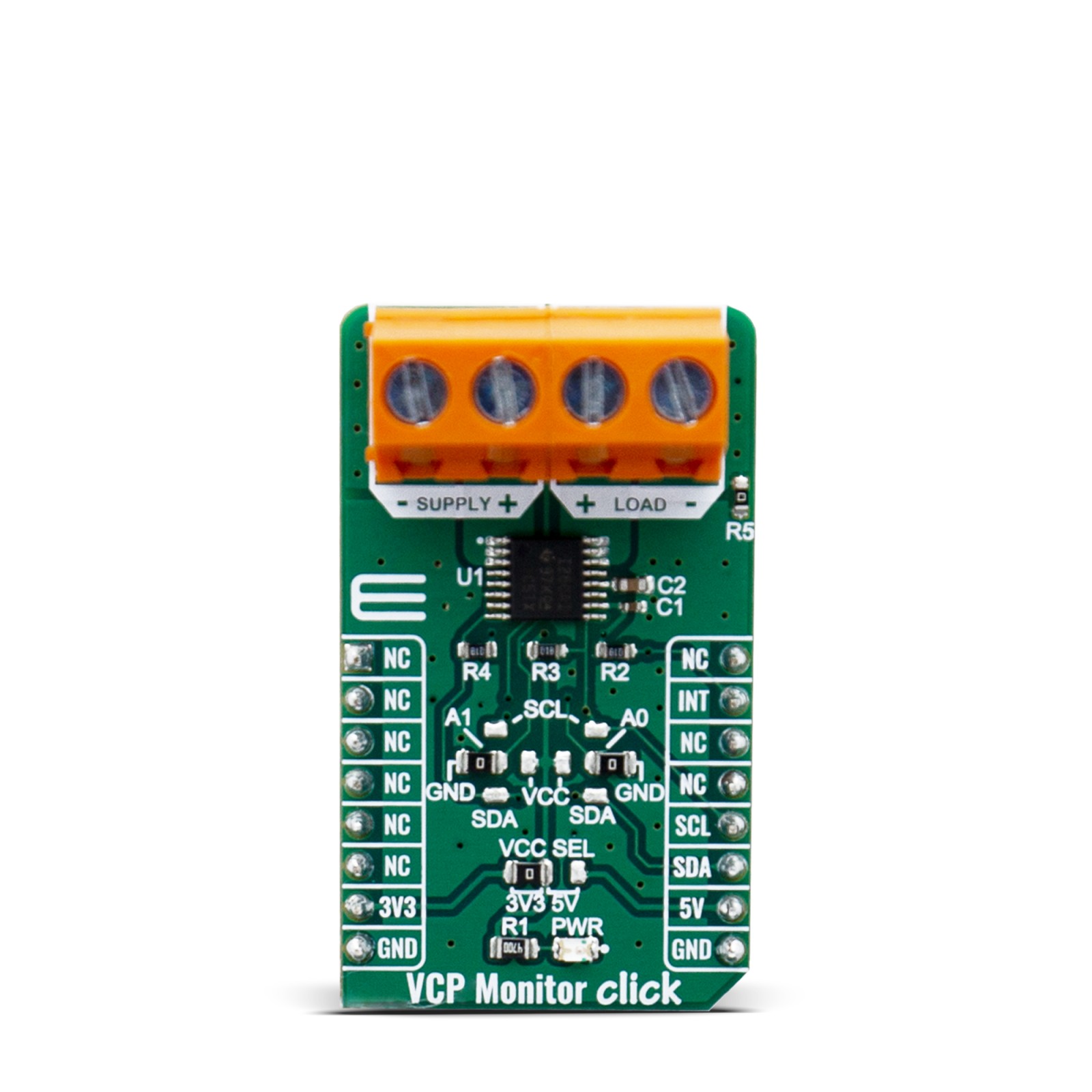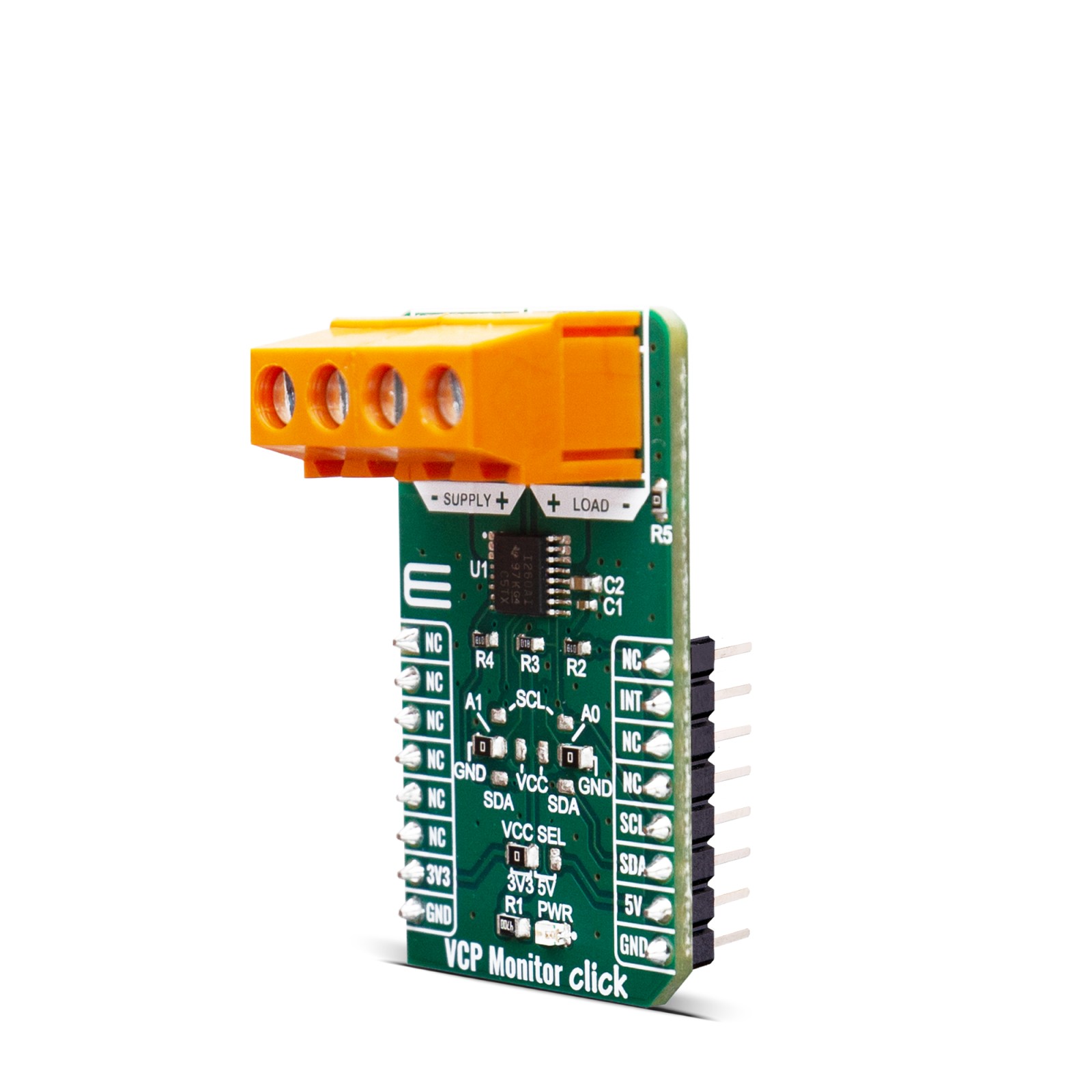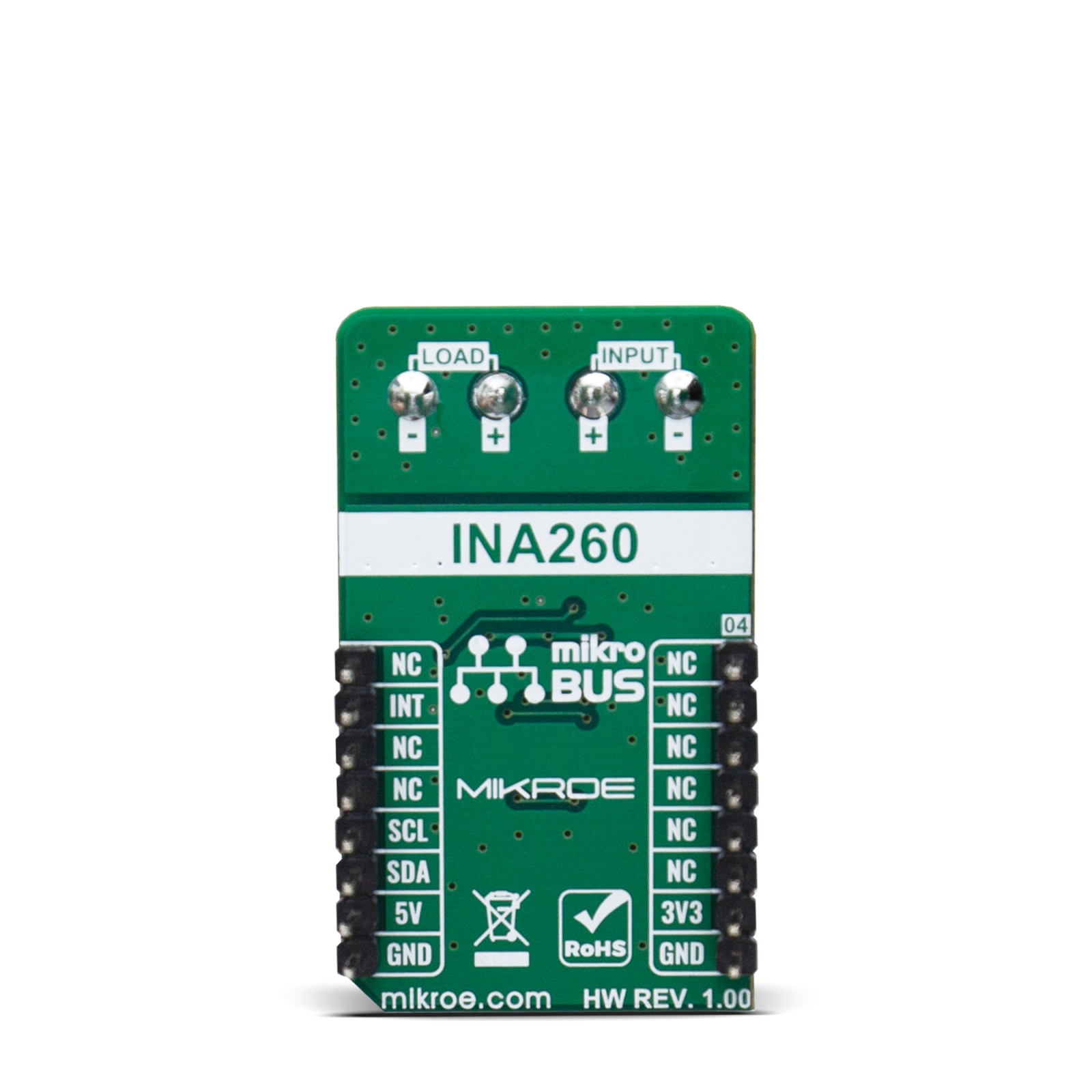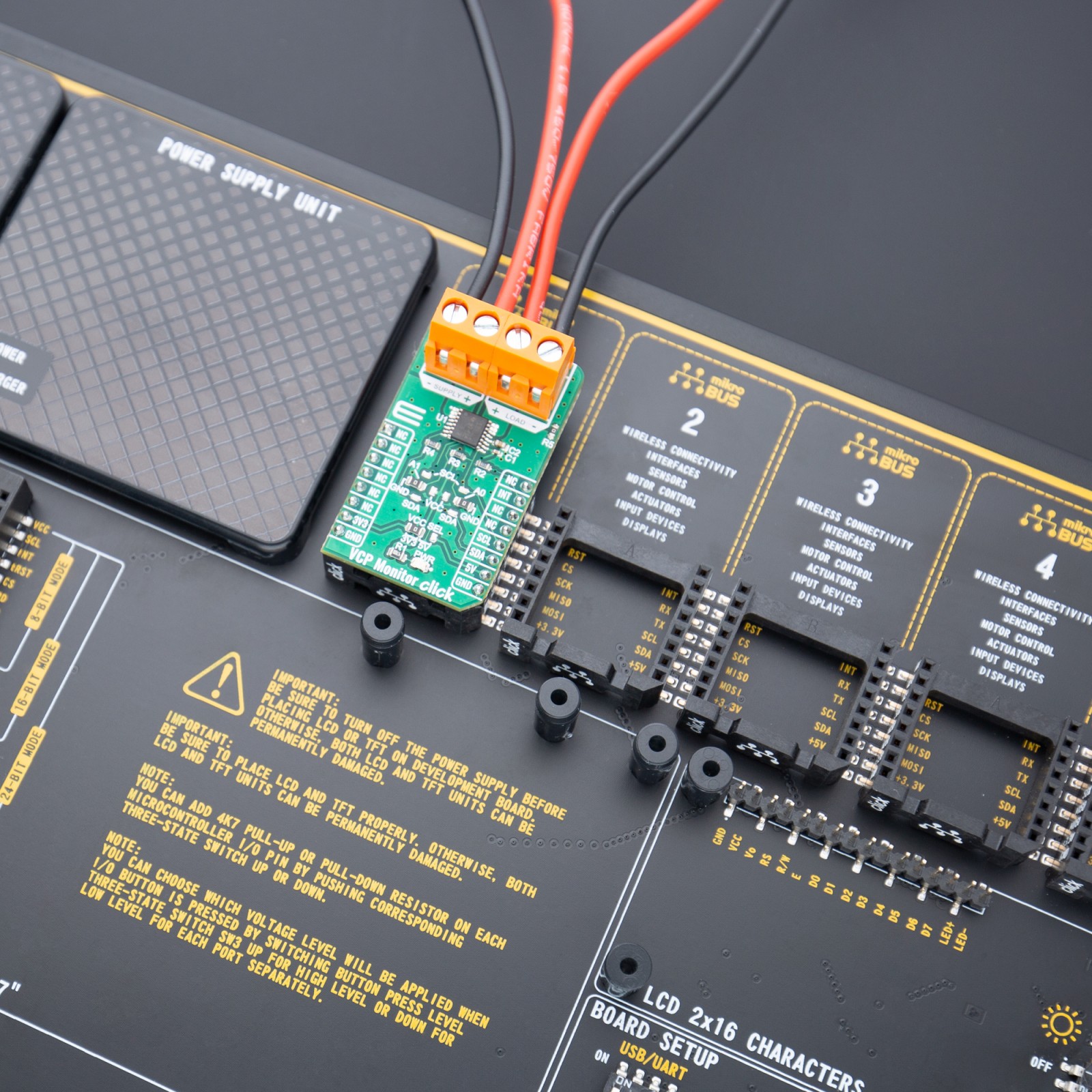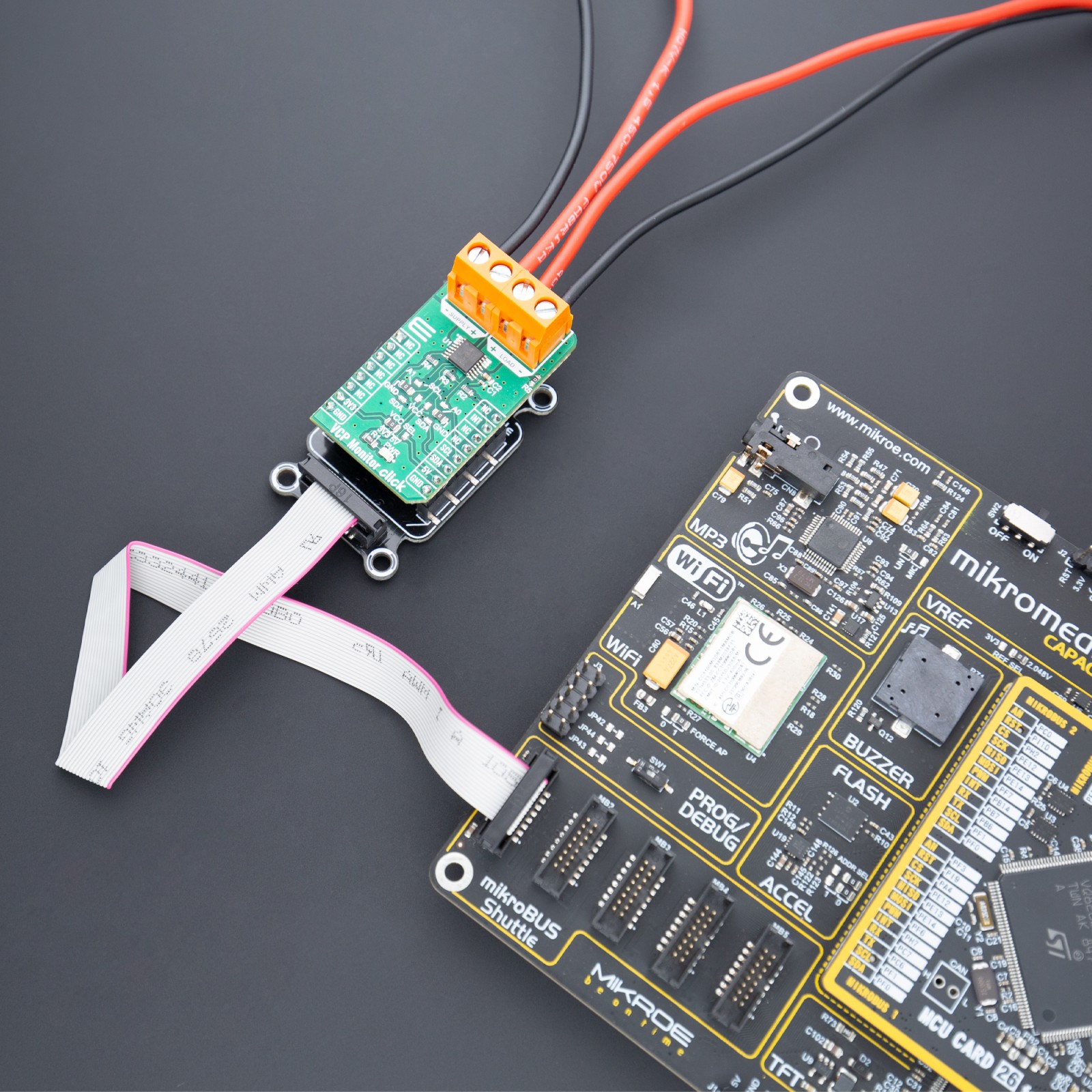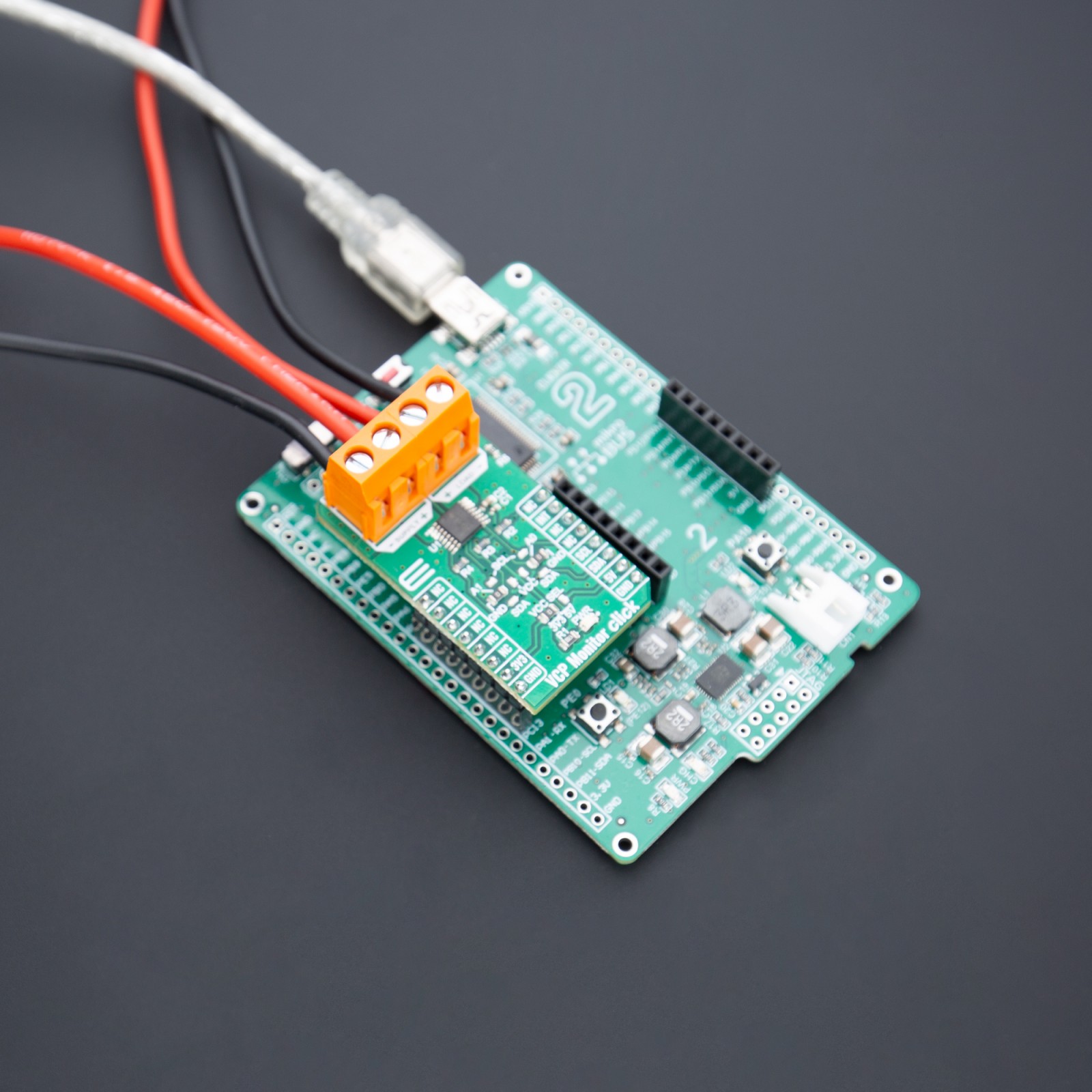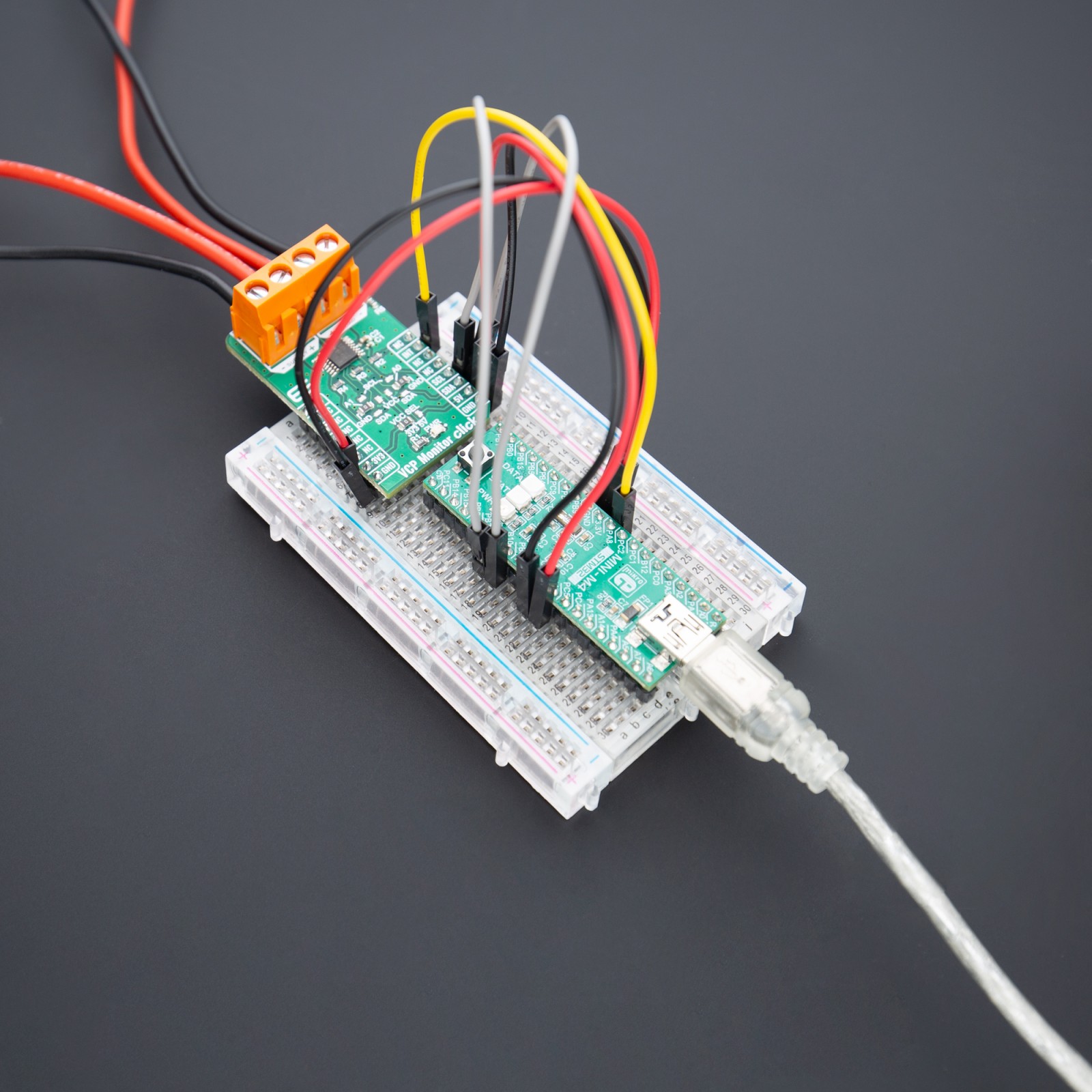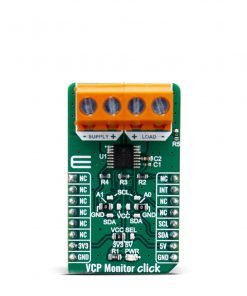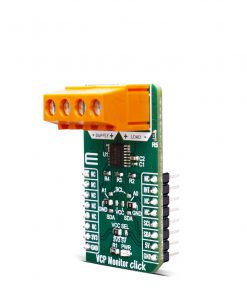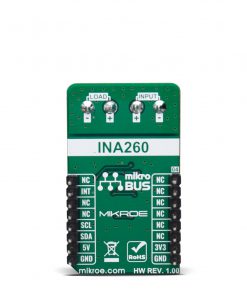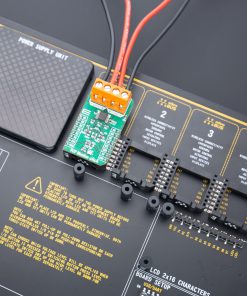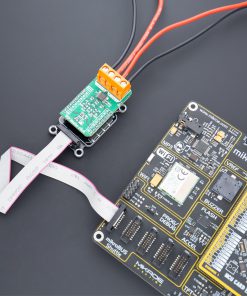VCP Monitor Click
R480.00 ex. VAT
The VCP Monitor Click is add-on board power monitor system. This Click board™ is based on INA260AIPWR – precision digital current and power monitor with low-drift, integrated precision shunt resistor, from Texas Instruments. Therefore, using VCP Monitor Click, current, voltage and power can be monitored. The integrated current-sensing resistor ensures measurement stability over temperature as well as simplifying printed-circuit board layout difficulties common in high precision current sensing measurements.
VCP Monitor click is supported by a mikroSDK compliant library, which includes functions that simplify software development. This Click board™ comes as a fully tested product, ready to be used on a system equipped with the mikroBUS™ socket.
Stock: Lead-time applicable.
| 5+ | R456.00 |
| 10+ | R432.00 |
| 15+ | R408.00 |
| 20+ | R392.64 |
How does it work?
The VCP Monitor click is power monitor system, which includes precision measurement of current, voltage and power with low-drift. The main IC on the VCP Monitor click is INA260AIPWR. The current-sensing resistor is designed as a 4 wire connected resistor that enables accurate measurements through a force-sense connection. The INA260AIPWR is internally calibrated to ensure that the current-sensing resistor and current-sensing amplifier are both precisely matched to one another.

The INA260AIPWR device performs two measurements on power supply bus. The current measurement on LOAD connector, is internally calculated by measuring the voltage developed across a known internal shunt resistor. The features is a physical shunt resistance that is able to withstand current levels higher than the continuous handling limit of 15 A without sustaining damage to the current-sensing resistor or the current-sensing amplifier if the excursions are very brief. The voltage measurement on SUPPLY connector witch is calculated by measuring the voltage from the external VBUS pin to ground. The voltage monitored range from 0V to 36V
The INA260AIPWR device performs two measurements on power supply bus. The current measurement on LOAD connector, is internally calculated by measuring the voltage developed across a known internal shunt resistor, and voltage measurement on SUPPLY connector wich is calculated by measuring the voltage from the external VBUS pin to ground.
The VCP Monitor click is compatibility with I2C communication protocol. The INA260AIPWR has two slave address selection pins, A0 and A1. For I2C slave address selection, VCP Monitor click has two cross-shape jumpers, first for set pin A0 and second for set A1 pin. One cross-shape jumper has four position for select address pin which can be selected with a SMD 0 ohm resistor, address pin can be connected to GND, VS, SCL or SDA pins. The VCP Monitor click with the two separate jumper on Click board™ user can to set the desired address. The INA260AIPWR provides the opportunity of the 16 possible different I2C addresses.
I2C Slave address selection
| A1 | A0 | Slave address |
|---|---|---|
| GND | GND | 1000000 |
| GND | VS | 1000001 |
| GND | SDA | 1000010 |
| GND | SCL | 1000011 |
| VS | GND | 1000100 |
| VS | VS | 1000101 |
| VS | SDA | 1000110 |
| VS | SCL | 1000111 |
| SDA | GND | 1001000 |
| SDA | VS | 1001001 |
| SDA | SDA | 1001010 |
| SDA | SCL | 1001011 |
| SCL | GND | 1001100 |
| SCL | VS | 1001101 |
| SCL | SDA | 1001110 |
| SCL | SCL | 1001111 |
The INA260AIPWR is supported with ALERT pin, which is connected to the INT pin on mikroBUS™, in order to interrupt the ongoing MCU routine in case of the alert condition. INT pin can be programmed to respond to a user-defined event or to a conversion ready notification.
The voltage level of the logic section can be selected via VCC SEL jumper, between 3.3V and 5V. This allows for both 3.3V and 5V capable MCUs to use the I2C communication lines properly.
Specifications
Type
Current sensor,Measurements
Applications
VCP Monitor click click is a perfect solution for the development of the Power Managment system, Battery Chargers and Power Supplies.
On-board modules
NA260AIPWR, a digital-output, current, power, and
voltage monitor with an I2C and SMBus™-compatible
interfacefrom Texas Instruments
Key Features
Current Sense Resistance: 2 mΩ, Tolerance Equivalent to 0.1%, 15-A Continuous From –40°C to +85°C, 16 Programmable Addresses.
Interface
I2C
Feature
No ClickID
Compatibility
mikroBUS™
Click board size
M (42.9 x 25.4 mm)
Input Voltage
3.3V or 5V
Pinout diagram
This table shows how the pinout on VCP Monitor click corresponds to the pinout on the mikroBUS™ socket (the latter shown in the two middle columns).
Onboard settings and indicators
| Label | Name | Default | Description |
|---|---|---|---|
| PWR | PWR | – | Power LED Indicator |
| JP1 | VCC SEL | Left | Power supply voltage selection 3v3/5v: left position 3v3, right position 5v |
| JP2,JP3 | ADD A0 | Left | 4-position I2C address Selection toward host mcu: left – GND; Right – VCC; Up – SCL; Down – SDA |
| JP4,JP5 | ADD A1 | Right | 4-position I2C address Selection toward host mcu: left – GND; Right – VCC; Up – SCL; Down – SDA |
VCP Monitor Click electrical specifications
| Description | Min | Typ | Max | Unit |
|---|---|---|---|---|
| Input voltage (SUPPLY terminal) | 0 | 36 | V | |
| Out voltage (LOAD terminal) | 0 | 36 | V | |
| OUT Current (LOAD terminal) | -15 | 15 | A |
Software Support
We provide a library for the VCP Monitor Click on our LibStock page, as well as a demo application (example), developed using MikroElektronika compilers. The demo can run on all the main MikroElektronika development boards.
Library Description
The library contains basic communication with the module and allows the user to read and write data to the module. The user can read the current data of current, voltage and power measured by the sensor.
Key functions:
float vcpmonitor_get_voltage ( void )– Reads voltage data in mVfloat vcpmonitor_get_current ( void )– Reads current data in mAfloat vcpmonitor_get_power ( void )– Reads power data in mW
Examples description
The application is composed of three sections :
- System Initialization – Initializes I2C module and INT pin on INPUT
- Application Initialization – Initializes driver init, check device ID and manufacture ID, start default configuration.
- Application Task – Reads Current, Voltage and Power data. This data logs to USB UART every 1500ms.
void application_task ( )
{
float current_data;
float voltage_data;
float power_data;
current_data = vcpmonitor_get_current( );
IntToStr( current_data, demo_text );
mikrobus_logWrite( ">> Current data: ", _LOG_TEXT );
mikrobus_logWrite( demo_text, _LOG_TEXT );
mikrobus_logWrite( " mA", _LOG_LINE );
voltage_data = vcpmonitor_get_voltage( );
IntToStr( voltage_data, demo_text );
mikrobus_logWrite( ">> Voltage data: ", _LOG_TEXT );
mikrobus_logWrite( demo_text, _LOG_TEXT );
mikrobus_logWrite( " mV", _LOG_LINE );
power_data = vcpmonitor_get_power( );
IntToStr( power_data, demo_text );
mikrobus_logWrite( ">> Power data: ", _LOG_TEXT );
mikrobus_logWrite( demo_text, _LOG_TEXT );
mikrobus_logWrite( " mW", _LOG_LINE );
mikrobus_logWrite( " ------------------------------- ", _LOG_LINE );
Delay_ms( 1500 );
}
The full application code, and ready to use projects can be found on our LibStock page.
Other mikroE Libraries used in the example:
- I2C Library
- Conversions library
Additional notes and informations
Depending on the development board you are using, you may need USB UART click, USB UART 2 click or RS232 click to connect to your PC, for development systems with no UART to USB interface available on the board. The terminal available in all MikroElektronika compilers, or any other terminal application of your choice, can be used to read the message.
mikroSDK
This Click board™ is supported with mikroSDK – MikroElektronika Software Development Kit. To ensure proper operation of mikroSDK compliant Click board™ demo applications, mikroSDK should be downloaded from the LibStock and installed for the compiler you are using.
For more information about mikroSDK, visit the official page.
Resources
Downloads
| Weight | 22 g |
|---|---|
| Brand | MikroElektronika |

